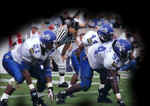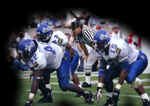

|
|
NFHS 2007 Football Rules Changes In Rule 2, the committee placed butt blocking, face tackling and spearing under the heading of “Helmet Contact – Illegal” to place more emphasis on risk-minimization concerns. In Rule 9-4-3, the committee added a note that lists examples of some types of illegal helmet contact that could result in disqualification. Examples of illegal helmet contact that could result in disqualification include, but are not limited to: a) illegal helmet contact against an opponent lying on the ground; b) illegal helmet contact against an opponent being held up by other players; and c) illegal helmet-to-helmet contact against a defenseless opponent. A new definition has been added. A flagrant foul will be defined as a foul that may or may not involve physical contact, but involves such acts as fighting, contacting a game official, fouls so severe as to place an opponent at risk, persistent or extreme abusive conduct and the use of vulgar language or gestures. The game jersey rule implementation has been moved up to 2012 and the changes made will provide manufacturers and schools a clearer direction on the specifications. In Rule 8-2-2, an enforcement option has been added when there is a foul by the opponent of a team scoring a touchdown. In addition to its previous option of accepting the result of the play and having the penalty enforced on the try-for-point, the scoring team may choose to have the foul enforced on the ensuing kickoff. Rule 1-2-3 contains two changes. A 4-inch-wide broken restraining line is now required around the outside of the field, and the line must be at least two yards from the sidelines and end lines. An exception has been made for facilities which do not have enough space to do this. In addition, a line, 4 inches wide by 12 inches ling, that bisects the limit line at each 5-yard line extended, may be used. There is now rule support for the location and dimension of the three-yard line marking in 1-2-3. Two new articles in Rule 10-4 have been added. These regard with basic spots for enforcement of penalties. The basic spot will be the 20-yard line for plays when the end of the related run is in the end zone followed by a loss of possession and the ball re-enters the playing field and then goes out of bounds. A passer is a player who throws a legal forward pass is a minor change in Rule 2-31-11. A change has also been made to provide the opportunity for a coach who assumes the head coaching responsibility during a game (when the head coach has been disqualified) to call a time-out. In 2008 required forearm pads to meet the same specifications as gloves and hand pads. These forearm pads will be required to have the NFHS/NCAA label attached. Changes in six-, eight- and nine-player football, reduce the free-blocking zone to a zone three yards on either side of the snap and three yards behind each line of scrimmage. Further discussion of these changes will be given in our 2007 Football Rules Clinics. Mike Webb, WVSSAC Football Clinician |
|
Football official pictures in the bannerof this web site by Bob Fiallo for Referee Magazine.Send mail to webmaster@rcfoa.com with
questions or comments about this web site.
|